
- •Read chapters from 8 to 9 and answer the following questions:
- •Read chapters from 10 to 13 and answer the following questions:
- •Read chapters from 18 to 20 and answer the following questions:
- •Insolent (adj)
- •Read chapters from 21 to 22 and answer the following questions:
- •Cultural Notes:
- •Read chapters from 23 to 25 and answer the following questions:
- •Cultural Notes:
- •Indigent (adj)
- •Cultural Notes:
- •Cultural Notes:
- •Cultural Notes:
- •Cultural Notes:
- •Cultural Notes:
- •Cultural notes:
- •Imprisonment and False Liberation
ASSIGNMENT PART
Read chapters from 1 to 3 and answer the following questions:
Give a characteristic of American society of the beginning of the XX century, as provided by the author.
What characters of the story are already mentioned in the first chapters? Describe them.
What characters of the mentioned ones were historical and what fictional?
Refer to the personality of Harry Houdini, describe his trade, explain the phrase “Today, nearly fifty years since his death, the audience for escapes is even large”.
Give a characteristic of the relationship in the family, in particular between Mother and Father. Refer to the phrase “The marriage seemed to flourish on Father's extended absences”
Refer to the episode of Father meeting a transatlantic vessel packed to the railings with immigrants. What does Father feel at that particular moment. Look up the chapters for some more information about immigrants coming to the US and the author’s opinion on the topic, quote the text to prove it.
Refer to the metaphoric description of water coming to dead bodies in morgues and tears (The faces of the dead were upturned into the streams of water that poured over them like the irrepressible mechanism in death of their own tears).
Describe the procedure of immigrants’ arriving to the US and their living conditions in the new land. Explain the phrase “the immigrant population set great store by the American flag“
Explain the meaning of the “crazy quilt of humanity” as seen by Jacob Riis. Speak about the irony of “dismantling of Europe”.
Look up the dictionary for the following words and statements:
Crest (n)
Dormer (n)
Bay window (n)
Awning (n)
Bunting (n)
Accoutrement (n)
Social outing (n)
Swarm (n)
Parlor (n)
Marsh (n)
Shoal (n), (v)
Towline (n)
Odd (adj.)
Shack (n)
To read between the lines
Scion (n)
Terra cotta (n)
Embellish (v)
Haze (n)
Volute (n)
Billow (n), (v)
Bondage (n)
Handcuffed (part.)
Strait jacket (n)
Rolltop desk (n)
Dishevel (v)
Penitentiary (n)
Padlock (v)
Swerve (v)
Demeanor (n)
The thermometer read…
Diffidence (n)
Amateur (adj.), (n)
Disbursement (n)
Voluble (adj.)
Deft tricks
Distort (v)
Coitus (n)
Gird for (v)
Gear (n)
Befit (v)
Varnish (v)
Restrain (v)
Doff (v)
Go around the bend
Prow (n)
Shawl (n)
Riffraff (n)
Insolent (adj.)
Derelict (n)
Babushka (n)
Galvanized iron
Pinafore (n)
Roam (v)
To become accustomed to
Air shaft (n)
Indigent (adj.)
Pennant (adj.), (n)
Crossbow (n)
Chaise (n)
Refectory table (n)
Harpsichord (n)
Snuffbox (n)
Hustler (n)
Exorbitant price
Cultural notes for chapters 1 -3:
S hingle
- The Shingle Style in America was made popular by the rise of the
New England school of architecture, which eschewed the highly
ornamented patterns of the Eastlake style. In the Shingle Style,
English influence was combined with the renewed interest in Colonial
American architecture which followed the 1876 celebration of the
Centennial. Architects emulated colonial houses' plain, shingled
surfaces as well as their massing, whether in the simple gable of
McKim Mead and White's Low House or in the complex massing of
Kragsyde, which looked almost as if a colonial house had been
fancifully expanded over many years. This impression of the passage
of time was enhanced by the use of shingles. Some architects, in
order to attain a weathered look on a new building, even had the
cedar shakes dipped in buttermilk, dried and then installed, to
leave a grayish tinge to the façade.
hingle
- The Shingle Style in America was made popular by the rise of the
New England school of architecture, which eschewed the highly
ornamented patterns of the Eastlake style. In the Shingle Style,
English influence was combined with the renewed interest in Colonial
American architecture which followed the 1876 celebration of the
Centennial. Architects emulated colonial houses' plain, shingled
surfaces as well as their massing, whether in the simple gable of
McKim Mead and White's Low House or in the complex massing of
Kragsyde, which looked almost as if a colonial house had been
fancifully expanded over many years. This impression of the passage
of time was enhanced by the use of shingles. Some architects, in
order to attain a weathered look on a new building, even had the
cedar shakes dipped in buttermilk, dried and then installed, to
leave a grayish tinge to the façade.
Fish fries - In the Southern portion of the United States, a fish fry is a family or social gathering, held outdoors or in large halls. At a typical fish fry, quantities of freshwater fish (such as bream, catfish, flounder and bass) available locally are battered and deep fried in cooking oil. The batter usually consists of corn meal, milk or buttermilk, and seasonings. In addition to the fish, hushpuppies (deep fried, seasoned corn dumplings), and cole slaw are served. These events are often potluck affairs. The world's largest fish fry is held each spring in Paris, Tennessee. In Georgia and South Carolina, fish are dipped in milk, then into a mix of flour, cornmeal and seasonings before frying. Buttered grits is often a side dish.
Vaudeville - was a theatrical genre of variety entertainment in the United States and Canada from the early 1880s until the early 1930s in which each performance was made up of a series of separate, unrelated acts grouped together on a common bill. Types of acts included popular and classical musicians, dancers, comedians, trained animals, magicians, female and male impersonators, acrobats, one-act plays or scenes from plays, athletes, lecturing celebrities, minstrels, and movies. Vaudeville developed from many sources, including the concert saloon, minstrelsy, freak shows, dime museums and literary burlesque. Dubbed by one "the heart of [the era's] American show business," vaudeville was one of the most popular types of entertainment in North America during the several decades of its existence.
Trolley - A tram, tramcar, trolley, trolleycar, or streetcar is a railborne vehicle, of lighter weight and construction than a train, designed for the transport of passengers (and, very occasionally, freight) within, close to, or between villages, towns and/or cities, on tracks running primarily on streets. Certain types of cable car are also known as trams.
Parasol - An umbrella or parasol (sometimes colloquially; gamp, brolly, umbrellery, or bumbershoot) is a canopy designed to protect against precipitation or sunlight. The term parasol usually refers to an item designed to protect from the sun.
B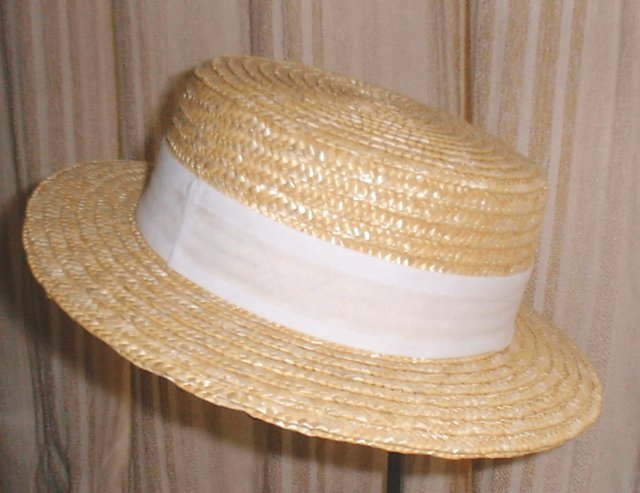 oater
- A boater (also basher, skimmer, katie, or sennit hat) is a kind of
hat associated with sailing and boating. It is normally made of
sennit straw and has a stiff or soft flat crown and brim, typically
with a ribbon around the crown, which is often in colours
representing a school, rowing crew or similar institution.
oater
- A boater (also basher, skimmer, katie, or sennit hat) is a kind of
hat associated with sailing and boating. It is normally made of
sennit straw and has a stiff or soft flat crown and brim, typically
with a ribbon around the crown, which is often in colours
representing a school, rowing crew or similar institution.
Madison Square Garden - often abbreviated as MSG and known colloquially as The Garden, has been the name of four arenas in New York City. It is also the name of the entity which owns the arena and several of the professional sports franchises which play there.
Mamzelle Champagne - Mam'zelle Champagne was a musical revue with book by Edgar Allan Woolf, music by Cassius Freeborn, produced by Henry Pincus, which opened June 25, 1906. On opening night at Madison Square Garden, millionaire playboy Harry K. Thaw shot and killed architect Stanford White: the musical's run continued for some 60 performances largely on the publicity from this incident.
S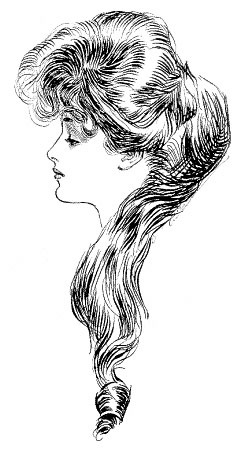 tanford
White was known to have seduced Thaw's wife, showgirl Evelyn Nesbit.
During the opening-night performance of Mam'zelle Champagne,
audience members noticed Thaw repeatedly glaring at White. Thaw
eventually got up, crossed over to White's seat and shot him
point-blank while the show onstage was in the midst of a number
titled "I Could Love a Million Girls". It has never been
established whether the subject matter of this particular song was a
factor in prompting Thaw to take action at that particular moment.
tanford
White was known to have seduced Thaw's wife, showgirl Evelyn Nesbit.
During the opening-night performance of Mam'zelle Champagne,
audience members noticed Thaw repeatedly glaring at White. Thaw
eventually got up, crossed over to White's seat and shot him
point-blank while the show onstage was in the midst of a number
titled "I Could Love a Million Girls". It has never been
established whether the subject matter of this particular song was a
factor in prompting Thaw to take action at that particular moment.
Charles Dana Gibson’s "The Eternal Question"
Peddler - a travelling vendor of goods.
Warn the Duke - In the original version of Ragtime, before editing, Doctorow wrote a chapter in which Houdini tells the Archduke Ferdinand that his life is in danger, and then German officials throw Houdini in jail. Doctorow cut it out, though, because it posed a dead end for Houdini's character. That's also why, when he's suspended from the Times building, he thinks back to the "boy staring at his reflection in the headlights" as he wonders about Franz Ferdinand's death.
Derby - The bowler hat, also known as a coke hat, derby (US) or billycock, is a hard felt hat with a rounded crown originally created in 1849.
Ellis Island - at the mouth of the Hudson River in New York Harbor, is the location of what was from January 1, 1892, until November 12, 1954 the main entry facility for immigrants entering the United States; the facility replaced the state-run Castle Garden Immigration Depot (1855–1890) in Manhattan. It is owned by the Federal government and is now part of the Statue of Liberty National Monument, under the jurisdiction of the US National Park Service. Ellis Island was also the subject of a border dispute between the states of New York and New Jersey (see below). It is situated predominantly in Jersey City, New Jersey, although a small portion of its territory falls within neighboring New York City.
P ope-Toledo
Runabout (see picture)
ope-Toledo
Runabout (see picture)
Winslow Homer - (February 24, 1836 – September 29, 1910) was an American landscape painter and printmaker, best known for his marine subjects. He is considered one of the foremost painters in 19th century America and a preeminent figure in American art.
Peary - Robert Edwin Peary (May 6, 1856 – February 20, 1920) was an American explorer who claimed to have been the first person, on April 6, 1909, to reach the geographic North Pole. Peary's claim was widely credited for most of the 20th century, though it was criticized even in its own day and is today widely doubted.
Jacob Riis - Jacob August Riis (May 3, 1849 - May 26, 1914), was a Danish-American social reformer, muckraking journalist and photographer. He is known for his dedication to using his photographic and journalistic talents to help the impoverished in New York City, which was the subject of most of his prolific writings and photography. He helped with the implementation of "model tenements" in New York with the help of humanitarian Lawrence Veiller. As one of the most prominent exponents of the newly practicable flash, he is considered a pioneer in photography.
Mameh, Tateh - Hebrew for Mother, Father
See the reference part for personalities of:
Stanford White
Harry K. Thaw
Evelyn Nesbit
Emma Goldman
Harry Houdini
Read chapters from 4 to 7 and answer the following questions:
Give a characteristic of the events following and preceding Stanford White’s murder as narrated from the side of Evelyn Nesbit.
Describe the conditions in which Harry K. Thaw was kept in jail? Speak about his manners and attitudes.
Describe the episode with Houdini’s “strange confrontation” during his prison escape and his reaction. What was the root of his depression?
Speak about the personality of Freud, what do you know about his works, explain the phrase “At least a decade would have to pass before Freud would have his revenge and see his ideas begin to destroy sex in America forever”. How did Freud come to the conclusion that “America is a mistake, a gigantic mistake”.
Speak about labor unions, why were they “an affront to God”, refer to the ironic juxtaposition of God and property. Quote the text. Did the labor unions protect all workers?
How did Evelyn Nesbit's concern for the thirty-two-year-old geriatric artist and his daughter begin?
Render the episode with poverty balls.
Explain the nature of Evelyn’s feeling for the Jewish family.
Look up the dictionary for the following words and statements:
Lapel (n)
Starboard (n)
Jam (v)
Disembark (v)
Fish chowder
Apron (n)
Horseshoe (n)
Constellation (n)
Emboss (v)
Torch (n)
Rehearse (v)
Testimony (n)
A regal dowager
Despise (v)
Connive (v)
Deranged (adj.)
Laudanum
Syringe (n)
Temple (n)
Imperious
Concoct (v)
Affidavit (n)
Chaperone (n)
Shriek (n)
Copulate (v)
Convalescence (n)
Tacit (adj.)
Laceration (n)
Tier (n)
Well (n)
Valet (n)
Impeccable style
Stoop (v)
Catwalk (n)
Tulle (n)
Coiffure (n)
Exaltation (n)
Suffuse (v)
Impend (v)
leg irons (n)
Warden (n)
To trade quips with (v)
Contrive (v)
Demur (v)
Profess (v)
Stunt (n)
Humidor (n)
Decanter (n)
On one’s person
Callus (n)
Makeshift (adj.)
A ventriloquist's dummy
Obscene (adj.)
Fumblingly (adv.)
Agile (adj.)
Fuddy-duddies
Iridescent (adj.)
Grips (n)
Yatter (v)
Composure (n)
Nemesis (n)
Commemorate (v)
Sleight of hand
Remonstration (n)
Clerestory windows
Auspicious (adj.)
Disciple (n)
Litchi nuts
Nickelodeon (n)
Yiddish (adj.)
Public facility (n)
Silhouette portraits
Mentor (n)
Embark (v)
Steeplechase (n)
Overcast (adj.)
Mangle (v)
Hansom (n)
Curb (n)
Nag (n)
Yoke (v)
Ragmen (n)
Livery (n)
Jodhpurs (n)
Muck (n)
Threadbare coat (n)
Slums (n)
Defile (v)
Vagrancy (n)
Dewy (adj.)
Drayman (n)
Plod by (v)
Inconspicuous (adj.)
Infer from (v)
Liaison (n)
Slanderous (adj.)
Infatuated (adj.)
Gaze (n), (v)
Intimidate (v)
Pushcart (n)
Chain latch (n)
Scandalize (v)
Cot (n)
Crockery (n)
Kinship (n)
Frail (adj.)
Tormented pride
Cultural notes for chapters 4 -7:
The Fourth Ward - the Fourth Ward was a working-class district by the East River waterfront of lower Manhattan.
The Tombs - "The Tombs" is the colloquial name for the Manhattan Detention Complex, a jail in lower Manhattan at 125 White Street, as well as the popular name of a series of downtown jails.[1] The nickname has been used for several structures dating from the early-mid 19th Century.
The Carmania - was a British passenger liner, which in World War I was converted to an armed merchant cruiser.
T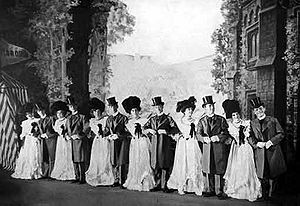 he
Floradora girls
- Florodora was an Edwardian musical comedy and became one of the
first successful Broadway musicals of the 20th century. The book was
written by Jimmy Davis under the pseudonym Owen Hall, music was by
Leslie Stuart with additional songs by Paul Rubens, and lyrics by
Edward Boyd-Jones and Rubens.
he
Floradora girls
- Florodora was an Edwardian musical comedy and became one of the
first successful Broadway musicals of the 20th century. The book was
written by Jimmy Davis under the pseudonym Owen Hall, music was by
Leslie Stuart with additional songs by Paul Rubens, and lyrics by
Edward Boyd-Jones and Rubens.
Delmonico's - Delmonico's Restaurant was one of the first continuously run restaurants in the United States and is considered to be one of the first American fine dining establishments. The first iteration opened in New York City in 1827. It operated at a number of locations continuously from 1827 to 1923; the name has since been revived periodically over recent decades by other restauranteurs having no continuity with the original establishment.
D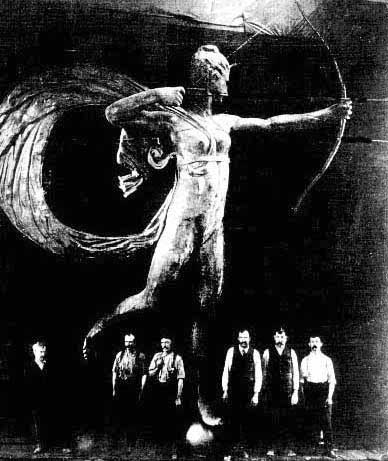 iana
of the Tower
- Diana of the Tower is a reduced version of a huge statue that
Augustus Saint-Gaudens created to top the tower of Madison Square
Gardens, an athletic arena in New York City designed by the
architect Stanford White. The classical goddess of the hunt not only
proclaimed that the building was devoted to sports but also rotated
so that her bow and arrow acted as a weather vane.
iana
of the Tower
- Diana of the Tower is a reduced version of a huge statue that
Augustus Saint-Gaudens created to top the tower of Madison Square
Gardens, an athletic arena in New York City designed by the
architect Stanford White. The classical goddess of the hunt not only
proclaimed that the building was devoted to sports but also rotated
so that her bow and arrow acted as a weather vane.
Theodore Dreiser - Theodore Herman Albert Dreiser (August 27, 1871 – December 28, 1945) was an American novelist and journalist. He pioneered the naturalist school and is known for portraying characters whose value lies not in their moral code, but in their persistence against all obstacles, and literary situations that more closely resemble studies of nature than tales of choice and agency.
Tiffany - Tiffany & Co. is a U.S. jewelry and silverware company founded by Charles Lewis Tiffany and Teddy Young in New York City in 1837 as a "stationery and fancy goods emporium."
Stuyvesant Fish - (June 24, 1851 - April 10, 1923) was president of the Illinois Central Railroad.
The Four Hundred - the social elite of New York City in the late 19th Century; the term was coined by Ward McAllister.
L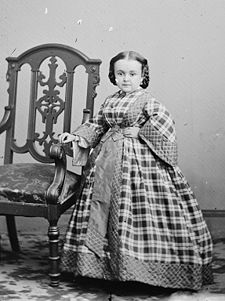 avinia
Warren - (1841
– 25 November, 1919) was an American proportionate dwarf and the
wife of General Tom Thumb.
avinia
Warren - (1841
– 25 November, 1919) was an American proportionate dwarf and the
wife of General Tom Thumb.
General Tom Thumb - was the stage name of Charles Sherwood Stratton (January 4, 1838 – July 15, 1883), a dwarf who achieved great fame under circus pioneer P.T. Barnum.
S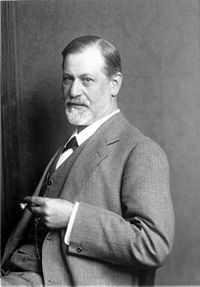 igmund
Freud – (Sigismund
Schlomo Freud, 6 May 1856 – 23 September 1939), was an Austrian
neurologist who founded the psychoanalytic school of psychology.
Freud is best known for his theories of the unconscious mind and the
defense mechanism of repression and for creating the clinical
practice of psychoanalysis for curing psychopathology through
dialogue between a patient and a psychoanalyst. Freud is also
renowned for his redefinition of sexual desire as the primary
motivational energy of human life, as well as his therapeutic
techniques, including the use of free association, his theory of
transference in the therapeutic relationship, and the interpretation
of dreams as sources of insight into unconscious desires. He was
also an early neurological researcher into cerebral palsy. While of
unique historical interest, many of Freud's ideas have fallen out of
favor or have been modified by Neo-Freudians, although at the close
of the 20th century, advances in the field of psychology began to
show flaws in many of his theories. Freud's methods and ideas remain
important in clinical psychodynamic approaches. In academia, his
ideas continue to influence the humanities and some social sciences.
igmund
Freud – (Sigismund
Schlomo Freud, 6 May 1856 – 23 September 1939), was an Austrian
neurologist who founded the psychoanalytic school of psychology.
Freud is best known for his theories of the unconscious mind and the
defense mechanism of repression and for creating the clinical
practice of psychoanalysis for curing psychopathology through
dialogue between a patient and a psychoanalyst. Freud is also
renowned for his redefinition of sexual desire as the primary
motivational energy of human life, as well as his therapeutic
techniques, including the use of free association, his theory of
transference in the therapeutic relationship, and the interpretation
of dreams as sources of insight into unconscious desires. He was
also an early neurological researcher into cerebral palsy. While of
unique historical interest, many of Freud's ideas have fallen out of
favor or have been modified by Neo-Freudians, although at the close
of the 20th century, advances in the field of psychology began to
show flaws in many of his theories. Freud's methods and ideas remain
important in clinical psychodynamic approaches. In academia, his
ideas continue to influence the humanities and some social sciences.
J ung,
Ferenczi, Drs. Ernest Jones, A. A. Brill – Freud’s
“disciples”, see the picture above.
ung,
Ferenczi, Drs. Ernest Jones, A. A. Brill – Freud’s
“disciples”, see the picture above.
Al Jolson - (May 26, 1886 – October 23, 1950) was a highly acclaimed Russian-born American singer, comedian, and actor, and the "first openly Jewish man to become an entertainment star in America".
Coney Island - Coney Island is a peninsula, formerly an island, in southernmost Brooklyn, New York City, USA, with a beach on the Atlantic Ocean. The area was a major resort and site of amusement parks that reached its peak in the early 20th century.
S hoot-the-chutes
- is an amusement ride consisting of a flat-bottomed boat that
slides down a ramp or inside a flume into a lagoon. Unlike a log
flume, a Shoot the Chutes generally has larger boats and one single
drop.
hoot-the-chutes
- is an amusement ride consisting of a flat-bottomed boat that
slides down a ramp or inside a flume into a lagoon. Unlike a log
flume, a Shoot the Chutes generally has larger boats and one single
drop.
Doge palace - The Doge's Palace is a gothic palace in Venice. In Italian it is called the Palazzo Ducale di Venezia. The palace was the residence of the Doge of Venice.
Read chapters from 8 to 9 and answer the following questions:
What was Emma Goldman talking about at her lecture? What was the essence of her words?
What happened in the meeting hall that Tateh disappeared with the Little Girl? What account for Goldman’s words to Evelyn “you're nothing more than a clever prostitute”?
Describe the episode with Evelyn’s liberation under Goldman’s emphatic hands.
What facts characterizing the MYB do we get from the 9-th chapter?
What other facts of the family do we get?
Describe the episode with Mother’s unexpected discovery in the garden. How did she react?
Look up the dictionary for the following words and statements:
Shirtwaist (n)
Foment (v)
Confess (v)
Dissection (n)
Hornrimmed glasses (n)
Catcall (n)
Repudiate (v)
Mockery (n)
Plunder
Brothel (n)
Decorum (n)
Womb (n)
Reverence (n)
Toady (v)
Phalanx (n)
Pandemonium (n)
Aisle (n)
Desecrate (v)
Duck trousers (n)
Brownstone (n)
Recess (n)
Lilac (n)
Dart (v)
Ajar (adj.)
Consolation (n)
Servitude (n)
Stem (v)
Abhor (v)
Urchin (n)
Rocking chair (n)
Novice (n)
Beleaguer (v)
Embroidered underwear (n)
Fulminate of mercury
Dungeon (n)
Parchment (n)
Stoop (n)
Leech (n)
Sybarite (n)
Obedient (adj.)
Waist (n)
Licentious (adj.)
Wanton (n)
Astringent (n)
Mon (n)
Pelvis (n)
Paroxysm (n)
Mortification (n)
Filamented (adj.)
Spurt (n)
Jism (n)
Ticker tape (n)
Brood about (v)
Oar (n)
Indolence (n)
Sire (v)
Homestead (n)
Gravid (adj.)
Hayloft (n)
Large-boned (adj.)
Slant (v)
Bid on (v)
Succeed (v)
Solace (n)
Salvia (n)
Marigold (n)
Translucent (adj.)
Cross oneself (v)
Opulent (adj.)
Infant (n)
Cord (n)
Swaddle (v)
Barely (adv.)
Receiver (n)
Guileless (adj.)
To stand charges (v)
Endorse (v)
Contamination (n)
Cultural notes for chapters 8 -9:
Emma Goldman – see the reference part.
I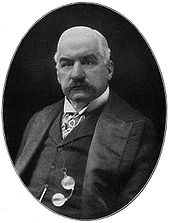 bsen
- Henrik
Johan Ibsen (20 March 1828 – 23 May 1906) was a major 19th-century
Norwegian playwright, theatre director, and poet. He is often
referred to as the "father of modern drama" and is one of
the founders of Modernism in the theatre. His plays were considered
scandalous to many of his era, when Victorian values of family life
and propriety largely held sway in Europe. Ibsen's work examined the
realities that lay behind many facades, possessing a revelatory
nature that was disquieting to many contemporaries. It utilized a
critical eye and free inquiry into the conditions of life and issues
of morality.
bsen
- Henrik
Johan Ibsen (20 March 1828 – 23 May 1906) was a major 19th-century
Norwegian playwright, theatre director, and poet. He is often
referred to as the "father of modern drama" and is one of
the founders of Modernism in the theatre. His plays were considered
scandalous to many of his era, when Victorian values of family life
and propriety largely held sway in Europe. Ibsen's work examined the
realities that lay behind many facades, possessing a revelatory
nature that was disquieting to many contemporaries. It utilized a
critical eye and free inquiry into the conditions of life and issues
of morality.
Pierpont Morgan - John Pierpont Morgan (April 17, 1837 – March 31, 1913) was an American financier, banker and art collector who dominated corporate finance and industrial consolidation during his time. In 1892 Morgan arranged the merger of Edison General Electric and Thompson-Houston Electric Company to form General Electric. After financing the creation of the Federal Steel Company he merged the Carnegie Steel Company and several other steel and iron businesses to form the United States Steel Corporation in 1901. He bequeathed much of his large art collection to the Metropolitan Museum of Art in New York City and to the Wadsworth Atheneum of Hartford, Connecticut. He died in Rome, Italy, in 1913 at the age of 75, leaving his fortune and business to his son, John Pierpont "Jack" Morgan, Jr.
John d. Rockefeller - John Davison Rockefeller (July 8, 1839 – May 23, 1937) was an American industrialist. Rockefeller revolutionized the petroleum industry and defined the structure of modern philanthropy. In 1870, he founded the Standard Oil Company and ran it until he officially retired in 1897.
Alexander Berkman - (November 21, 1870 – June 28, 1936) was an anarchist known for his political activism and writing. He was a leading member of the anarchist movement in the early 20th century.
Mr. Carnegie - Andrew Carnegie (25 November 1835 – 11 August 1919) was a Scottish-born American industrialist, businessman, and a major philanthropist. He was an immigrant as a child with his parents. He built Pittsburgh's Carnegie Steel Company, which was later merged with Elbert H. Gary's Federal Steel Company and several smaller companies to create U.S. Steel. With the fortune he made from business, he turned to philanthropy and interests in education, founding the Carnegie Corporation of New York, Carnegie Endowment for International Peace, Carnegie Mellon University and the Carnegie Museums of Pittsburgh.
Pinkertons - The Pinkerton National Detective Agency, usually shortened to the Pinkertons, was a private U.S. security guard and detective agency established by Allan Pinkerton in 1850. Pinkerton had become famous when he foiled a plot to assassinate president-elect Abraham Lincoln, who later hired Pinkerton agents for his personal security during the Civil War. Pinkerton's agents performed services ranging from security guarding to private military contracting work. At its height, the Pinkerton National Detective Agency employed more agents than there were members of the standing army of the United States of America, causing the state of Ohio to outlaw the agency due to fears it could be hired out as a private army or militia.
State militia - The term militia is commonly used today to refer to a military force composed of ordinary citizens to provide defense, emergency law enforcement, or paramilitary service, in times of emergency without being paid a regular salary or committed to a fixed term of service.
Attentat - assassination attempt (from German)
John Brown - (1800–1859), American who led an anti-slavery revolt in Harpers Ferry, Virginia in 1859.
Blue coats – police.
